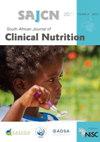开发和测试孕妇补充铁的营养教育工具
IF 0.6
Q4 NUTRITION & DIETETICS
引用次数: 0
摘要
本文章由计算机程序翻译,如有差异,请以英文原文为准。
Development and testing of a nutrition education tool on iron supplementation for pregnant women
Background: Although iron supplementation may prevent iron deficiency anaemia (IDA) during pregnancy, a nutrition education tool highlighting the importance of iron supplementation during pregnancy is also important. Objectives: The aim was to develop and test a nutrition education tool on iron supplementation for pregnant women. Design: A cross-sectional study was conducted. Setting: Mutare City Clinic, Manicaland province, Zimbabwe. Subjects: Sixty-seven pregnant women in their second or third trimesters of pregnancy and attending Mutare City Clinic for antenatal care (ANC) participated in the study. Outcome measures: The preferences of pregnant women regarding form, structure and content of the nutrition education tool were established using eight focus-group discussions (FGDs) in which 67 pregnant women participated. Three additional FGDs were conducted with another 28 pregnant women to assess the user-friendliness and acceptability of the developed tool. Results: A pamphlet was the most preferred tool, with English being the most preferred language, along with some Shona phrases. Women wanted information on IDA, dosage, duration and side-effects of iron supplementation and iron food sources to be included in the pamphlet. The participants identified clinics, pharmacies and churches as ideal sites for dissemination of the tool. Conclusions: A pamphlet on iron supplementation in simple English with some Shona phrases was the nutrition education tool most preferred by the pregnant women. Offering the pamphlet together with iron supplements to pregnant women could improve compliance with iron supplements. However, follow-up ANC consultations are important for effective implementation of all key messages in the pamphlet.
求助全文
通过发布文献求助,成功后即可免费获取论文全文。
去求助
来源期刊

South African Journal of Clinical Nutrition
NUTRITION & DIETETICS-
CiteScore
2.50
自引率
9.10%
发文量
21
期刊介绍:
1.The Journal accepts articles from all basic and applied areas of dietetics and human nutrition, including clinical nutrition, community nutrition, food science, food policy, food service management, nutrition policy and public health nutrition. 2.The Journal has a broad interpretation of the field of nutrition and recognizes that there are many factors that determine nutritional status and that need to be the subject of scientific investigation and reported in the Journal. 3.The Journal seeks to serve a broad readership and to provide information that will be useful to the scientific community, the academic community, government and non-government stakeholders in the nutrition field, policy makers and industry.
 求助内容:
求助内容: 应助结果提醒方式:
应助结果提醒方式:


